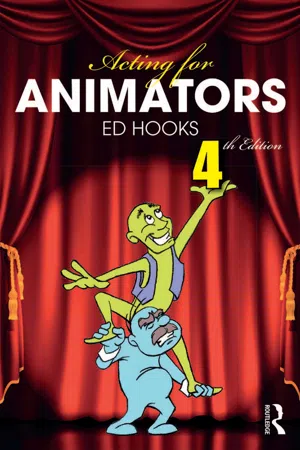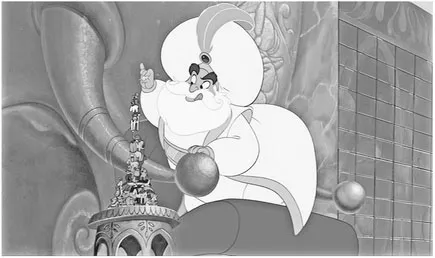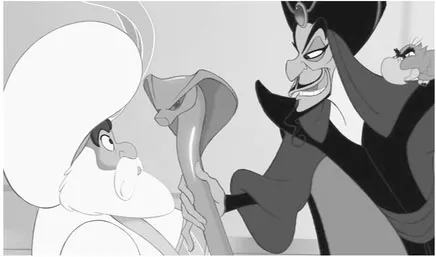![]()
Acting analyses
Aladdin (1992)
Walt Disney Pictures/Buena Vista Pictures
Codirected by John Musker and Ron Clements
Length: 90 min
Budget: $28m
Disney’s Aladdin is a very successful movie by Hollywood standards. Produced in 1992 for a comparatively paltry US$28 million, it has grossed US$504 million to date worldwide and was nominated for five Academy Awards, winning two. It was the first animated feature film for which a voice star, Robin Williams in this case, was featured prominently in the marketing campaign, a strategy that is commonplace today. Largely due to Robin’s manic improvisational performance and Eric Goldberg’s equally manic animation of the Genie, Aladdin is adored by many animators. There are two reasons I have chosen to include the movie in this book: (1) There are a few sequences that contain clear acting errors and (2) as good as the movie is, it could arguably have been even better if the creative team had explored further the possible surrogate father/son relationship between the Genie and Aladdin. Doing so would have expanded its appeal to adults while not compromising its appeal to kids.
Before starting the following analysis, I suggest that you read “Relation-ships are the way characters feel about each other” on page 27 of this book. It is important to keep in mind that “relationship” has to do with the way that characters feel about each other and is not the same thing as the facts, or “given circumstances”, in the story. The Genie is a spirit that has been imprisoned in a lantern for thousands of years, and Aladdin is a homeless petty-thief “street rat” living hand-to-mouth in the fictional Arabian city of Agrabah. Those are the facts, the given circumstances for the characters; they tell us nothing at all about their relationship. In fact, at the beginning of the movie, they have no relationship at all because they have never met. Once Aladdin frees the Genie from his lantern-prison, the Genie grants him three wishes. Again, these are only facts, information that is necessary if you want to understand the events of the narrative.
Note that, when the Genie is explaining to Aladdin the parameters of the kind of wishes he can grant, the very first exclusion has to do with romantic love. “I cannot cause someone to fall in love,” he says. That line telegraphs that romantic love is going to play an important role in this movie. Why can’t the genie cause people to fall in love? His other wish-provisos include an inability to bring people back from the dead, a restriction he explains by saying, “I don’t like to do it.” Fair enough, he doesn’t like to do it. Then it must also be that he doesn’t like to cause people to fall in love, yes? This must be a personal choice the Genie is making and, even though it is never mentioned in the movie, it is reasonable for the creative team to speculate on the Genie’s motivations. My totally-made-up guess is that the Genie himself has had unfortunate experiences with love. For whatever reason, he has concluded that magically causing people to fall in love is never, ever a good idea, and that is why he itemizes that wish-exclusion. If you accept this premise, then you have a perfect setup for the Genie to function as a surrogate father figure for Aladdin when the boy starts doing crazy and self-destructive things in order to win Princess Jasmine’s love.
It is a fool’s game to second-guess the creative decisions that are made during production of a major motion picture, and I am offering this interpretation of the Genie-Aladdin relationship with all due respect to the movie’s creative team. It appears to me that they were enamored of Robin Williams’s crazy and loveable improvisations, and they had a swell time turning all of that into fun animation. It does not look to me like there was any effort made to explore relationships deeply and, since the primary intended audience for Aladdin was young, psychological complexity was unnecessary.
The story, based on the folktale Aladdin and the Magic Lamp from 1,001 Arabian Nights, did not originally include the Genie’s wish restrictions. The Disney creative team made that up, which raises perhaps a larger question about why they did not more fully flesh out relationships. It appears the “I can’t make people fall in love” exclusion was simply a story-function device because the creative team knew that Aladdin and Jasmine were going to be involved. If Aladdin had been able to simply wish Jasmine’s love into existence, there would be no story to tell. Hence, the exclusion.
In this analysis, I will not spend much time with Robin Williams and his improvisations. IMDb’s page for Aladdin includes the trivia point that Mr. Williams ultimately provided 16 script pages of improvisations. This kind of stream-of-consciousness comedy technique was what Robin Williams did, and it had nothing whatever to do with scriptwriting. The creative team on this film simply encouraged Robin to do his thing, and then they used whatever they could in the movie. Most of his improvisations and impersonations are not theatrically valid. There is rarely an objective, actions and obstacles. Instead, the improvs are like a carnival sideshow featuring Robin Williams. It is what it is, and there is not much for me to talk about in an acting analysis.
A note about the anthropomorphic animals in Aladdin: In my view, the creative team went a little too far with the animals. It is one thing to endow them with human brains and emotions, but it is another to change the structure of their vocal apparatus so they can enunciate English words. This is a particularly obvious overstep for Abu the monkey. He comes very close to speaking full-throated English, just like a human. The animals in Aladdin are clearly intended to be animals, not simply another example of Pinocchio’s Jiminy Cricket.
1:00–3:00 A Peddler, voice-acted by Robin Williams, sets the stage, speaking directly to camera. He says we are in Agrabah and then shows us the empty genie lamp. The sequence is purely informational, not theatrically valid because it lacks conflict-obstacle, and it automatically renders the entire movie a big flashback episode. As a screenwriting device, flashback should be used sparingly, and it should justify itself dramatically, which is not the case here. Presumably, the Peddler is showing us the very lamp that we will soon learn is home to the Robin Williams Genie, right? And, at the end of the movie, the villain Jafar and his parrot are trapped in the same lantern. The newly liberated Genie, in the final sequence, throws the lamp containing Jafar into the far distance, to spend “10,000 years in the Cave of Wonders”. If the lamp ends up in the Cave of Wonders for 10,000 years, then how is it that the Peddler has possession of it here in the opening sequence? It doesn’t make sense. If the directors wanted to use this Peddler sequence properly, then the Peddler would have another scene at the end of the movie. This entire sequence is superfluous to the story and, in fact, misleads the audience.
For an example of flashback used effectively, consider Orson Wells’s Citizen Kane, when newspaper mogul Charles Foster Kane mutters the word “rosebud” when he dies in the opening scene. The rest of the movie is an investigation into the significance of that single word. In animation, flashback was used effectively by Isao Takahata in The Grave of the Fireflies . In the opening scene, we learn that the two lead characters, a young boy and his younger sister, die. The rest of the movie follows their futile efforts to survive during the World War II Allied bombing of Kobe, Japan.
Mainly, this Peddler sequence in Aladdin provides a mini-platform for Robin Williams to do a few more crazy improvisations.
3:00–4:15 Jafar locates the Cave of Wonders. This is a strong acting sequence because we first are introduced to Jafar when he is mid-quest, furiously pursuing his objective, which is to find the Cave of Wonders. Action, conflict and objective are clear.
4:15–6:30 Jafar sends henchman Gazeem into the Cave of Wonders to fetch the Genie lamp. Theatrically valid, clear objective, logical action, obvious conflict-obstacle. Also, Jafar’s quest seems motivated by emotion, which is good because the expression of emotion is how we connect with a character’s personal values. In this moment, we are able to empathize just a tiny bit with the movie’s antagonist. We may not agree with Jafar’s values, but we can all relate to being driven by passion. Gazeem’s performance is strong.
6:31–10:25 Aladdin and his monkey, Abu, are introduced in a big musical number, “One Jump Ahead”. They steal a loaf of bread, escape the law and then give the bread to hungry street children. This is the kind of thing that the famous choreographer Bob Fosse used to call an “I am” number, in which a character tells the audience who he is. In this case, the lyrics of the song describe precisely what we are watching on the screen, so the song itself is not adding anything to the mix except attitude. We learn that Aladdin is a total scamp, a petty thief and low-level opportunist. He survives by using street smarts and is a risk-taker in terms of his personal safety. At the end of the number, when he and Abu have safely escaped with their loaf of stolen bread, Aladdin sees a couple of hungry children and gives his bread to them. Now we know that, in addition to being a petty thief, he has a heart of gold. As the story develops, the tension between these two aspects of his personality are often highlighted. Acting-wise, Aladdin’s objective during the song is to safely escape with his stolen loaf of bread, and he has conflict with his situation as well as the police chasing him. Once he and Abu are safe, and Aladdin sees the two hungry children, his objective changes to “Feed the children.” His conflict is with himself since he is also hungry.
10:25–12:00 Prince Achmed arrives at Sultan’ s Palace to propose marriage to Princess Jasmine. He insults Aladdin, calling him a “street rat”. When left alone, Aladdin states his long-term objective – which is really more of a dream at this point – that he will one day be rich, live in a palace and never have any problems at all. Both Achmed and Aladdin are giving strong performances in this sequence. You could freeze-frame them at any point and ask, “What are you doing?”, and they would have theatrically valid answers – action, objective, obstacle.
12:10–14:09 The Sultan’s objective is to marry off his daughter, Princess Jasmine. Jasmine’s performance in this sequence is weak. She is reacting rather ineffectually to her father’s admonishments. For a stronger performance, she could be actively trying to convince her father to support her desire to “marry for love”. (A scene is a negotiation.) Then she would be doing something, playing an action in pursuit of a provable objective, plus she would have conflict with her situation and another character.
The Sultan is the most underdeveloped character in the movie, representing quite a significant missed opportunity creatively. You get the impression while watching him that, because he is Sultan, he doesn’t have anything to do but putter around the palace and meddle in Jasmine’s life. I would have liked to see him more involved with the world around him. Historically, sultans have been heads of state, heads of government. Their words have been the law. They answered only to God. This movie’s Sultan is a cartoon, a cardboard cut-out, a cuddly and bumbling character, and that is unfortunate. The creative team could have done a lot with him.
The Sultan constructs a tower of little toys. This is another example of the character having very little to do, both in terms of his daily life and his role in the film. © 1992, Disney
At 14:05, we see Jasmine develop the idea to run away. Releasing the palace pigeons from their cage is a metaphor for her own freedom.
14:15–16:05 Jafar dominates and controls the Sultan by hypnotizing him with a magic staff. This is a weak, even careless storytelling device for two major reasons: 1) The audience wants on-screen characters to be responsible for their own choices in life. That is a prime reason we enjoy watching movies in the first place. If the Sultan is hypnotized, he cannot be held responsible for his actions. 2) If Jafar is so easily able to control the Sultan, what are his limits? Why doesn’t he have the Sultan simply give him half of the wealth in the kingdom? Major studio feature animation directors too often expect their audiences to overlook this kind of storytelling sloppiness on the grounds that “it’s animation!” However, it is not the case that animation gets to ignore sound and proven principles of structured narrative just because the art form is animation. Story is story is story, and it deserves respect unilaterally.
Jafar uses his viper -staff to hypnotize the Sultan. This image illustrates the point I make about how hypnotizing the Sultan reduces the theatrical value of the character ...


